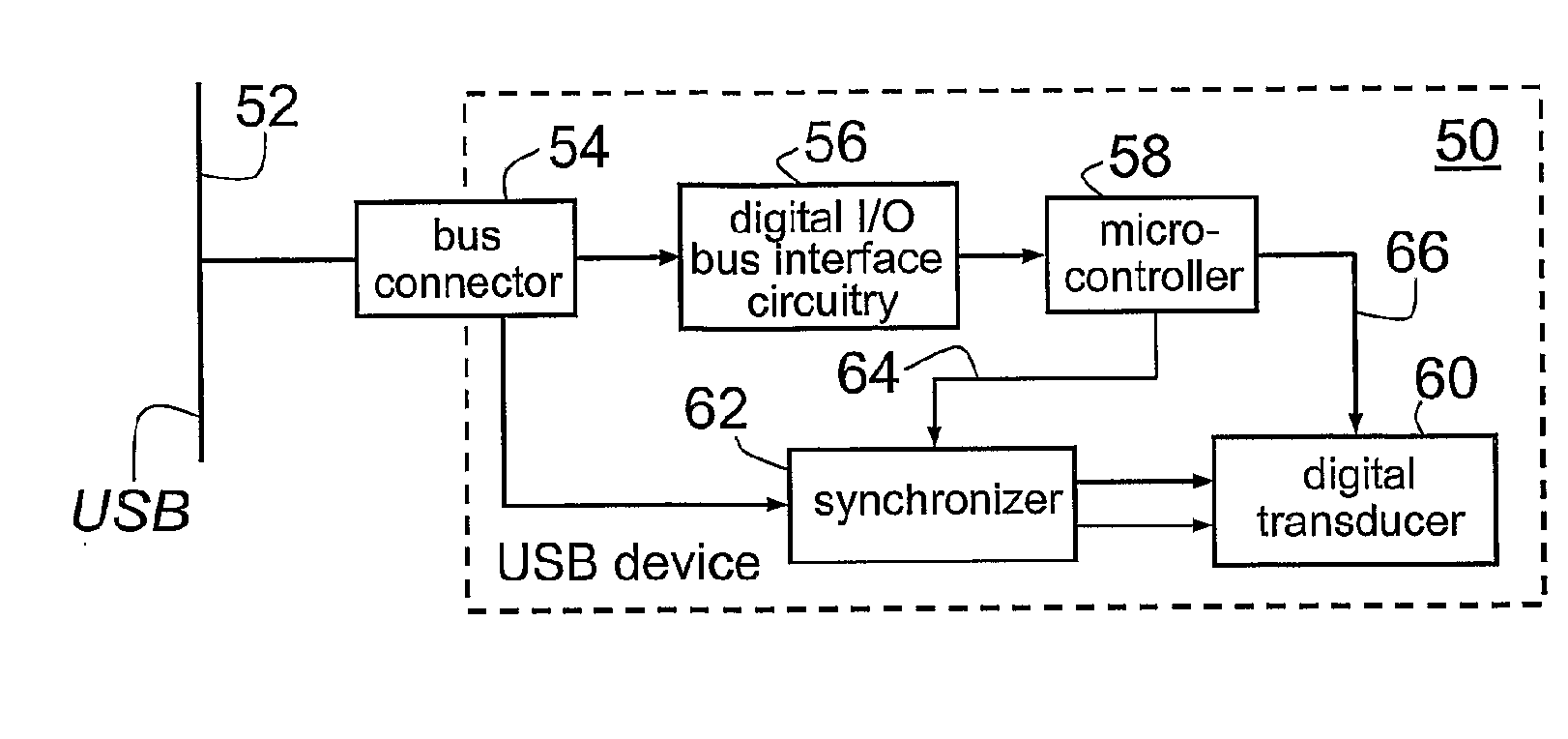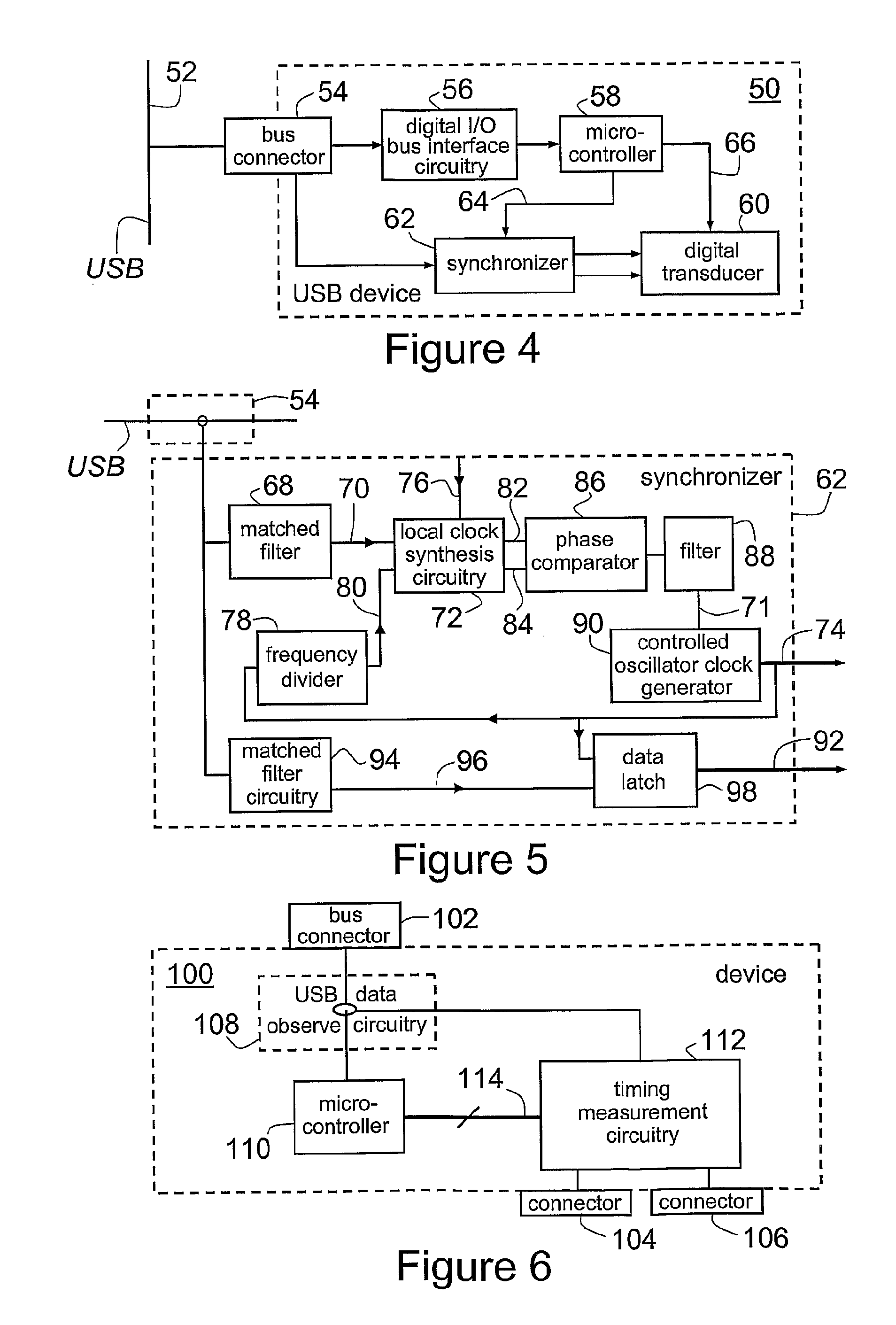Distributed synchronization and timing system
a timing system and synchronization technology, applied in the direction of digital transmission, generating/distributing signals, instruments, etc., can solve the problems of severe restrictions, insufficient specification, and the inability to accurately time-stamp
- Summary
- Abstract
- Description
- Claims
- Application Information
AI Technical Summary
Benefits of technology
Problems solved by technology
Method used
Image
Examples
first embodiment
[0121]A USB device according to the present invention is shown schematically at 50 in FIG. 4, with a USB 52. In this embodiment, clock synchronization information to allow the local clock of the USB device 50 to be frequency controlled to an arbitrary degree is passed to the USB device by a carrier signal (described below) that is then decoded from the USB data stream.
[0122]Referring to FIG. 4, USB device 50 includes a bus connector 54, digital I / O bus interface circuitry 56, a microcontroller 58, a digitally controlled transducer 60 and synchronization circuitry in the form of synchronizer 62 (described in greater detail below). The digital I / O bus interface circuitry 56 acts as a transceiver for USB data detected at bus connector 54, passing the USB data to microcontroller 58. The microcontroller 58 provides information 64 to synchronizer 62 for accurate frequency synthesis and a direct control channel 66 to digitally controlled transducer 60.
[0123]The carrier signal referred to a...
second embodiment
[0129]As discussed above, the SOF packet broadcast occurs at a nominal frequency of 1 kHz but the actual frequency of this signal is determined by the accuracy of the USB Host Controller clock. A USB device 100 according to the invention employs a method for determining the effective clock rate of the USB Host Controller by accurately measuring the frequency of the SOF packet. This signal can then be considered a carrier for information about the Host Controller clock rate and the carrier signal is broadcast to all connected USB devices. The carrier signal embedded in the normal USB protocol is thus decoded and its frequency measured to determine the effective clock rate of the USB Host Controller clock.
[0130]Thus, FIG. 6 is a schematic diagram of a device 100 for synchronizing a USB according to a second embodiment of the invention, which includes a USB bus connector 102 for connection to a USB. Device 100 has a first connector 104 for receiving an external reference clock signal, ...
third embodiment
[0135]FIG. 8 is a schematic diagram of a USB system 140 according to the present invention, in which a personal computer 142 with a USB Host Controller 144 is attached to a single USB device 146 at a USB 148. The USB device 144 contains timing measurement circuitry 150 (as per timing measurement circuitry 112 of FIG. 7) to measure repetitive carrier signal frequency using an internal reference clock (comparable to local reference clock 130 of FIG. 7) to an arbitrary degree. Thus, in this embodiment the absolute frequency of the clock carrier signal of the USB Host Controller 144 is determined by means of circuitry (i.e. the timing measurement circuitry 150) contained solely within a USB device. Further, it will be apparent to those skilled in the art that, although this embodiment includes a personal computer, alternative similar embodiments may instead include any device, such as a personal digital assistant (PDA) or mobile communication device, that contains a USB host controller ...
PUM
 Login to View More
Login to View More Abstract
Description
Claims
Application Information
 Login to View More
Login to View More - R&D
- Intellectual Property
- Life Sciences
- Materials
- Tech Scout
- Unparalleled Data Quality
- Higher Quality Content
- 60% Fewer Hallucinations
Browse by: Latest US Patents, China's latest patents, Technical Efficacy Thesaurus, Application Domain, Technology Topic, Popular Technical Reports.
© 2025 PatSnap. All rights reserved.Legal|Privacy policy|Modern Slavery Act Transparency Statement|Sitemap|About US| Contact US: help@patsnap.com



